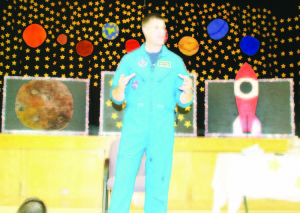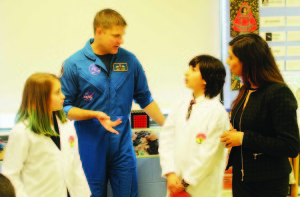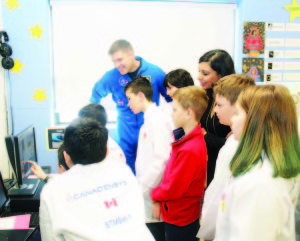|
This page was exported from Caledon Citizen
[ https://caledoncitizen.com ] Export date: Fri Apr 4 23:28:42 2025 / +0000 GMT |
Students learn about space exploration from astronaut  The stage at St. John Paul II Elementary School in Bolton was appropriately decorated last Thursday as the school welcomed Canadian astronaut Lt.-Col. Jeremy Hansen. He was given a tour of the school's Satellite Remote Mission Operations Centre (RMOC).  Students Isabella Bracaglia and Dylan Kurnath were among those conducting the tour of the Satellite Remote Mission Operations Centre (RMOC) at St. John Paul II School for astronaut Jeremy Hansen and Brampton North MP Ruby Sahota. Hansen was pretty impressed with what he saw in the RMOC.  Jeremy Hansen was pretty impressed with what he saw in the RMOC. By Bill Rea Students at St. John Paul II Elementary School in Bolton are looking forward to soon receiving images from a satellite in orbit. The project is part of a cooperative effort between the local school and St. Thomas More Cathedral School in Arlington, Virginia. The local students received a trill last week when their Satellite Remote Mission Operations Centre (RMOC) was toured by Canadian astronaut Lt.-Col. Jeremy Hansen. In addition to the tour, Hansen also took time to address the students, working to inspire them to pursue their dreams, as he was able to do. Hansen stressed the vastness of space. With the help of a visual presentation, he showed the students one of the stars that makes up the sword in the constellation Orion. But he said that the Hubble Space Telescope has made it possible to take a closer look, and determine there are really about 3,000 stars making up that one point in space. He also said that's about 13 light years away. “We can't go there,” he said. “We don't have a space ship that cool yet.” And there's a lot more beyond that. Hansen told the students there might be 200 billion stars in this galaxy, and possibly 100 billion galaxies in the universe. “There are more stars in the universe than there are grains of sand on our planet,” he said. “We're just starting to scratch the surface.” Hansen, who is now 40, was born after the Apollo moon missions, but he said he's looked up at the moon and realized there are human boot prints up there. “We can do amazing things when we set big goals,” he told the students, encouraging to set goals for themselves, and telling people of these goals so then can help achieve them. Hansen said he grew up on a farm outside London, Ontario. He wanted to fly, and he recalled his father telling him about the Air Cadets, pointing out they could teach him to fly for free. “Air Cadets built me up,” Hansen declared, observing they helped his get his glider's licence at 16. He eventually joined the Armed Forces, and learned to pilot the F-16 Hornet. He told one girl the Air Cadets set challenges for him, and that helped him build up his self-confidence; something he said he had been lacking prior to that. He also had a goal to fly in space, but he has not yet done that. He was hired by the Canadian Space Agency six years ago, joining a class of 14 astronauts from various countries and backgrounds. “We set goals and we told people about them,” he said. Hansen also told the students that once they set their goals, the one thing that will prevent them from achieving them in not believing in themselves. “People taught me to believe in myself,” he said, adding he tries to surround himself with people who believe in him. Hansen said he's training to work on the Internation Space Station (ISS). “It's the size of a football field,” he said, adding it's in orbit about 400 kilometres above the earth, circling the globe every 90 minutes, or about the length of the average movie. “I can't wait to do that,” he declared. ISS was built through international partnerships. “We all had to work together to build this amazing station,” he told the students. “It's our school in space. It's where we go to learn.” Hansen pointed out there are a lot of advantages to conducting experiments in micro-gravity, because the usual forces we're accustomed to can sometimes get in the way. He showed a video of Canadian astronaut Chris Hadfield demonstrating what happens to the water when a soaking wet washcloth is wrung out in space. The water stuck to Hadfield's hands, almost like a coating of Jello. They are also learning a lot about how the human body responds when not subjected to gravity. Muscles aren't used the way they normally are, and there isn't the usual pressure on bones. It will take about eight months to travel to Mars, so keeping the body in shape is going to have to be addressed. Hansen stressed the importance of cooperation in the work done on ISS. It represents great goals, and the bringing together of a lot of people to help achieve them. “They accomplished things they could not have accomplished on their own,” he observed. Hansen also pointed out commercial companies are now putting money into getting people into space. As that continues, it's going to become cheaper to send more people up, and they're going to be needed. “We're going to need great minds to work in the space industry,” Hansen declared. “There's going to be space tourism in your lifetime,” he added. Hansen said astronauts see the world in a different way from other people. They don't see political boundaries from space. “We have to work together to take care of this planet, and more importantly, of each other,” he commented. Hansen doesn't know when he'll be assigned to a mission to go into space. One girl asked him what he would do with any free time he has up there. “I imagine the thing I'll do the most is look out the window,” he told her. “Privacy is not something astronauts get a lot of,” he told another student. He said the sleeping area is like a coffin. They do have access to computers, and can do things like contact their families. Part of the training includes working in space suits under water. He said the effect is similar to being in space. He also tried to keep in mind while training how things would be different in space. “I just try to use common sense,” he said, adding he also watches what other astronauts do. Hansen also said the space walk training can be very tiring, especially under water. He said they are in their space suits for several hours at a time, with no breaks or opportunities to visit the washroom. He added the suit is designed to keep air in, much like a balloon. If he has to move, it means squeezing that balloon, which can get exhausting. “How do I keep going?” he responded a question. “I just refuse to stop.” Although he doesn't yet know when he'll get to fly in space, Hansen said he's not nervous about it. If he's going to be nervous, he figures it will be the day before the launch, when he expects to be “very contemplative.” The actual day of the launch, he thinks he'll be excited and exhilarated. “You just get down to work and get it done,” he said. Hansen also very impressed with what he saw in the tour of RMOC, which was conducted by several of the students. “It was a huge honour,” Grade 5 student Dylan Kurnath remarked.”He made me feel welcome. I really enjoyed shaking hands with him.” Canadensys Aerospace is providing the RMOC hardware and support to the students and teachers as technical advisor for the project in Canada. Students will use the RMOC to receive images taken and transmitted by the STMSAT-1 satellite as it orbits the earth. The satellite, built by St. Thomas More School in Virginia, will fly in an orbit 300 kilometres above the Earth, take pictures every 30 seconds and transmit them via radio waves back to the ground. The satellite is the first ever in the world to be built and designed entirely by grade school students, supported by technical advisors from NASA. Once the satellite is in its final orbit, students will have the opportunity to experience real-life space mission operations from tracking the satellite as it passes overhead and receiving the transmitted images, to archiving them and interpreting the data received. “Our students are eagerly anticipating the visit of Astronaut Jeremy Hansen to be able to show-off their work and the RMOC, and to hear him share some of his own experiences,” commented St. John Paul II Principal George Consitt a few days before the visit. “They're looking forward to the satellite launching from the space station and being able to get their first chance to receive data and images from it. As you can imagine, to describe excitement levels at the school as high would be an understatement!” Dylan said the scheduled launch date for the satellite is May 11. “Hopefully, it does go off that day,” he said. |
|
Post date: 2016-04-15 20:17:09 Post date GMT: 2016-04-16 00:17:09 Post modified date: 2016-04-21 20:15:36 Post modified date GMT: 2016-04-22 00:15:36 |
| Powered by [ Universal Post Manager ] plugin. HTML saving format developed by gVectors Team www.gVectors.com |